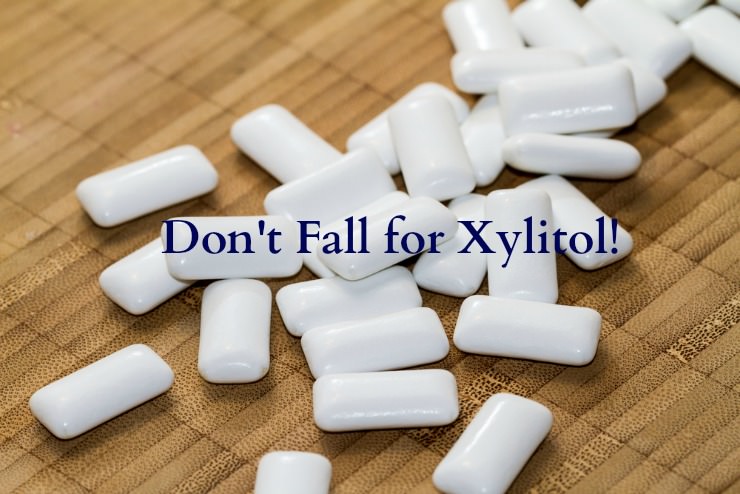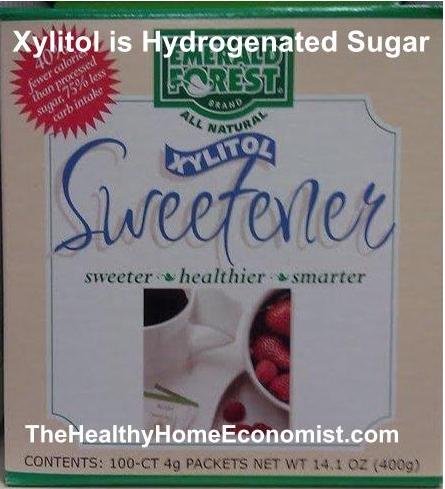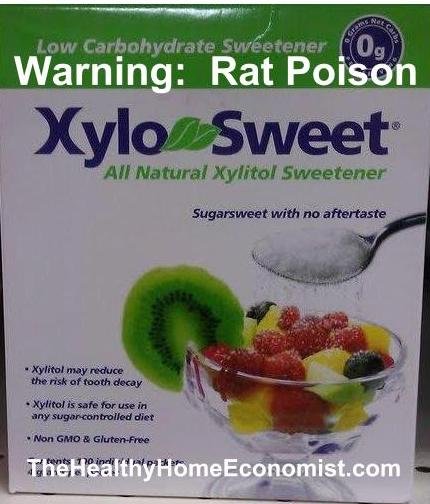
Xylitol is truly the darling of sugar substitutes today. The American Dietetic Association touts its use, with this sugar alcohol sold alone and as a sweetener in a variety of processed foods. Health benefits include a reduced glycemic response compared with sucrose, increased absorption of B vitamins and calcium, and even a reduction in dental caries risk.
Consequently, people with blood sugar issues are flocking to processed foods containing this alternative sweetener as a way to satisfy that sweet tooth without the downside of exacerbating the risk factors for Metabolic Syndrome. This condition is known for the markedly increased likelihood of developing heart disease, stroke, and type 2 diabetes.
Even the healthfood community almost universally considers this sugar alcohol to be a healthy substitute for sugar. A primary reason is that it doesn’t directly contribute toward the growth of intestinal yeasts aka Candida.
Have you noticed that the check out aisles at health food stores are typically loaded with chocolates and other sweets containing at least some xylitol? The truth is that I have yet to talk with any health-conscious person who suggests to me any downside other than the potential for intestinal cramps if you get too much.
Xylitol is Naturally Found in Nature
Xylitol is, after all, a naturally occurring substance. Manufacturers of xylitol market it as derived from xylan. The fibers of many plants contain it, including berries, oats, beets, sugar cane and birch. Sounds pretty harmless at first glance.
The FDA has even granted xylitol GRAS (Generally Recognized As Safe) status. You can’t get any safer than that, right?
 Manufacturing Process
Manufacturing Process
It is true that xylitol is a naturally occurring substance. However, manufactured xylitol is another matter entirely. Food manufacturers produce it using the industrialized process of sugar hydrogenation. In order to hydrogenate anything, a catalyst is needed. In this case, Raney nickel is used which is a powdered nickel-aluminum alloy. (1, 2)
This poses the risk of heavy metal residue and contamination. Nickel, by the way, is a recognized carcinogen and aluminum is associated with the development of dementia. Heavy metals in the body are notoriously difficult to eliminate with frequent use of infrared sauna probably a good idea.
This alternative sweetener doesn’t seem quite so warm and fuzzy anymore, does it?
There is currently no literature on any detrimental health effects of consuming hydrogenated sugar. However, food manufacturers widely used hydrogenated fats for decades before the very damaging effects of cardiovascular health became widely known!
Given the violent industrialized process that is required to produce a hydrogenated sugar like xylitol, it would seem wise to avoid it based on the very poor track record of hydrogenated foods in general.
Most Xylitol Sourced from GMO Corn
While it is true that xylitol can be derived from the xylan of birch trees, xylan is also found in corn cobs. It is much cheaper to use corn instead of birch bark to derive xylitol and so what do you think manufacturers prefer? Corn, of course.
Therefore, unless the label of a xylitol-containing product specifically notes that it is from birch or another nonGMO source, xylitol is very likely from genetically modified corn or possibly GMO sugar beets.
This is the same problem as high fructose corn syrup (HFCS) and white sugar from beets. Food manufacturers rely heavily on these sweeteners in the production of sodas and sports drinks.
You get a dose of GMOs with every sip! More on GMO dangers including sterility and stomach holes at the provided link.
Usage Contributes to Gut Imbalance
The digestive process does not break down sugar alcohols like food. Rather, xylitol arrives intact into the intestines.
At that point, a process called “passive diffusion” takes place. This means that the xylitol draws water into the bowels. Only a partial breakdown is the end result. The unmetabolized portion ferments providing the perfect environment for undesirable bacteria to thrive and grow.
It is true that xylitol itself does not feed candida directly as sugar does. As a result, this artificial sweetener is even promoted as a useful part of the Candida Diet. Unfortunately, the fermentation of undigested xylitol in the gut most definitely can exacerbate yeast problems. Don’t be fooled by this argument!
This is exactly why consuming xylitol can make some folks so gassy and even trigger cramping and diarrhea. Gut pathogens having a heyday in your intestines give off a lot of smelly toxins!
Other Little Known Problems
Xylitol can contribute to acid reflux problems. As a result, those who have issues in this area should avoid it for that reason alone. Chronic acid reflux is a serious problem that can lead to cancer of the esophagus and larynx.
In addition, those who suffer from seizures of any kind should stay away from this alternative sweetener as it can increase the frequency of epileptic attacks.
Two Pieces of Xylitol Gum Can Kill a Rat?
According to unpublished lab tests, approximately 1.65 grams of xylitol kills a 100-gram rat half the time.
Two little pieces of xylitol gum contain about .7 – 1 gram. This is probably enough to meet the definition of rat poison.

Cavity Prevention
Many people are chewing xylitol gum due to compelling scientific evidence for cavity prevention. What about children, however?
Rami Nagel, author of Cure Tooth Decay, doesn’t even recommend xylitol gum for this purpose. His research for any long term safety data turned up the following:
- Epidemiology: No information found
- Teratogenicity: No information found
- Reproductive Effects: No information found
- Mutagenicity: No information found
- Neurotoxicity: No information found
In summary, using this modern substance officially renders you a guinea pig, my friend! It seems that any benefits of cavity prevention are outweighed by the fact that there is no actual safety data backing up its use.
Safe Uses of Xylitol
Given all the problems that consumption of xylitol can trigger, it seems best to bypass the use of this sugar substitute on a regular basis.
Can it ever be helpful? Does it have any benefits whatsoever?
Potentially so. The only time I personally would ever consider using xylitol is to help resolve a childhood ear or sinus infection in order to prevent the use of drug-based antibiotics.
There is evidence that this popular sugar alcohol can indeed help encourage a healthy balance of beneficial bacteria found in the ear canal and sinus cavities. Products like this incorporate xylitol for this purpose.
A therapeutic dose can help resolve infection in these areas quickly with no medication required.
Thus, if you choose to use it, make sure it is sparingly and therapeutically (not as food). Also, make sure it does not come from a GMO source like corn!
References
(1) Xylitol production via catalytic hydrogenation of sugarcane
(2) Catalytic hydrogenation of xylose to xylitol using ruthenium catalyst on NiO modified TiO2 support
(3) Cure Tooth Decay by Rami Nagel
(4) Sugar-Free Blues: Everything You Wanted to Know about Artificial Sweeteners
More Information
Yacon: Healthy Syrup or Healthfood Hype?
Jaggery: India’s Sweet Gift








I think the mint & gum brand Zellie’s is ok, isn’t it?
They say non-GMO. Thanks for all your research!
More thoughts? I finally just found out that Xylitol from xclear does not have Gmo corn but it is made from corn . do you think using corn in this instance is acceptable ( as a occasional nasal spray) ? This is close to the brain, I personally don’t eat grains at this point, but am wondering if this would be a good tool to have hand. Thank you
A good article and I appreciate the facts. I have been in the “xylitol is a good alternative” camp for a while (have researched health since my college days, and am a healthy 72 now). I knew what they say about digestion in the gut and all, but we use it sparingly–or were. Now a bit more in baking, mixed with monk fruit and Erythritol. So, this is a caution. However, I’m sure you know that the amount correlation from rats to people means that a 10 lb child would have to eat 2 1/2 pounds at one time to get the same amount–besides the fact that animals and humans do not exactly correspond (e.g. canines). A 150 lb adult would need about 40 pounds to be toxic. I am more concerned about the heavy metals, did not at all realize that. I get mine from the birch tree, and I don’t think any hydrogenation (although I do not understand yet how that corresponds to fatty acid hydrogenation, which makes fats rancid. Never heard of sugar hydrogenation in all these years. The indigestion is also a concern, as gut health and digestion is vital for general health. Thanks again.
Just a note. I have epilepsy, and chronic dry mouth. I was told to use sugar free gum (xylitol) for my dry mouth problem, and my neurologist said NOTHING about xylitol interacting with my (two) medications. He was more concerned about my lack of a gall bladder and it potentially causing stomach ulcers, diarrhea, etc.. If you plan to continue to make that BS claim about interactions with anti-convulsants I suggest you post a link to articles in either the AMAJournal or TheLancet, not to pages that share your opinion, and have no basis in actual fact. It is Aspertame that may cause interactions with epilepsy medications.
Please read this article on xylitol again. There are ZERO gold standard, placebo controlled studies on the safety of xylitol.
Searches in the medical literature turned up the following:
Epidemiology: No information found
Teratogenicity: No information found
Reproductive Effects: No information found
Mutagenicity: No information found
Neurotoxicity: No information found
It seems your doctor is happy with his patients being guinea pigs.
By the way, did your doctor mention the health issues that can result from chewing gum all the time? https://www.thehealthyhomeeconomist.com/the-sticky-truth-about-chewing-gum/
Your cognitive dissonance doesn’t make the information in this article untrue 🙂
Can anyone then recommend a safe and effective fluoride-free toothpaste for children? (Children who still swallow the toothpaste as well as older kiddos)? There doesn’t seem to be a truly safe product out there without sugars, colors, fluoride, glycerin, etc.
I recently bought a tooth powder on Amazon that you might be interested in. It’s called “Uncle Harry’s All Natural Tooth Powder”
These are the ingredients:
Calcium carbonate (natural chalk), sea salt, mustard seed powder, essential oils of peppermint, eucalyptus, clove, wintergreen, and oregano.
Apparently it is a bit spicy, perhaps your children would only need a little bit. It is a powder but you can essentially use as a paste.
Squigle Sensitive Toothpaste has no flavorings or fluoride and other bad stuff, and a lot of xylitol. Since it is spit out it isn’t an issue
Just be sure it comes from Birch…
HOW DOES XYLITOL WORK?
Xylitol prevents caries in several ways. First, it interferes with the bacteria’s ability to produce acid. Second, it blocks communication between bacteria so they stop producing the polysaccharide slime that holds the biofilm together. Third, it raises the pH of the mouth. Cariogenic bacteria prefer living in a low pH environment and produce the acid that demineralizes enamel. In the presence of xylitol, the bacteria stop producing acid and the polysaccharide slime that holds the biofilm together, and they simply slide off the teeth. In the presence of sugar, bacteria thrive, produce acid and stick to the teeth. Bacterial numbers are significantly reduced in the presence of xylitol. Xylitol promotes an alkaline oral environment which is conducive to oral health.